开头段和结尾段的写法
作文开头和结尾的几种写法汇总
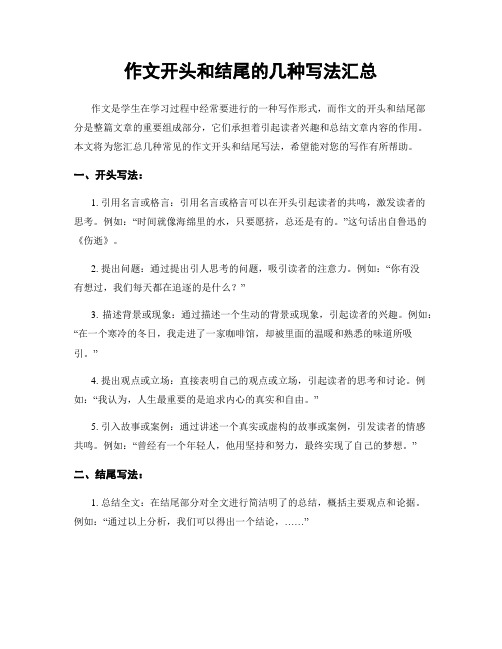
作文开头和结尾的几种写法汇总作文是学生在学习过程中经常要进行的一种写作形式,而作文的开头和结尾部分是整篇文章的重要组成部分,它们承担着引起读者兴趣和总结文章内容的作用。
本文将为您汇总几种常见的作文开头和结尾写法,希望能对您的写作有所帮助。
一、开头写法:1. 引用名言或格言:引用名言或格言可以在开头引起读者的共鸣,激发读者的思考。
例如:“时间就像海绵里的水,只要愿挤,总还是有的。
”这句话出自鲁迅的《伤逝》。
2. 提出问题:通过提出引人思考的问题,吸引读者的注意力。
例如:“你有没有想过,我们每天都在追逐的是什么?”3. 描述背景或现象:通过描述一个生动的背景或现象,引起读者的兴趣。
例如:“在一个寒冷的冬日,我走进了一家咖啡馆,却被里面的温暖和熟悉的味道所吸引。
”4. 提出观点或立场:直接表明自己的观点或立场,引起读者的思考和讨论。
例如:“我认为,人生最重要的是追求内心的真实和自由。
”5. 引入故事或案例:通过讲述一个真实或虚构的故事或案例,引发读者的情感共鸣。
例如:“曾经有一个年轻人,他用坚持和努力,最终实现了自己的梦想。
”二、结尾写法:1. 总结全文:在结尾部分对全文进行简洁明了的总结,概括主要观点和论据。
例如:“通过以上分析,我们可以得出一个结论,……”2. 提出建议或展望未来:在结尾部分提出具体的建议或展望未来的发展,给读者留下深刻的印象。
例如:“在未来,我们应该更加重视环境保护,共同创造一个美好的家园。
”3. 引用名言或格言:通过引用名言或格言来强调文章的主题或给读者以启示。
例如:“正如李白所说,‘人生自古谁无死,留取丹心照汗青。
’”4. 提出反问或留下悬念:通过提出反问或留下悬念,引发读者的思考和讨论。
例如:“我们是否应该重新审视自己的价值观?”5. 结尾呼应开头:在结尾部分呼应开头部分的内容,形成一个完整的循环结构。
例如:“回想起刚才提出的问题,我想说……”总之,作文的开头和结尾是整篇文章的亮点和收尾,它们的写法直接影响着读者对整篇文章的印象和理解。
六年级下册语文第三单元作文的万能开头结尾

六年级下册语文第三单元作文的万能开头结尾全文共8篇示例,供读者参考篇1亲爱的同学们:你们是否经常在写作文的时候苦恼于不知道如何开头和结尾呢?没关系,今天我就来给大家支几个宝贵的小建议,让你们的作文开头和结尾都妙不可言,绝对能让老师和家长赞不绝口哦!一、开头部分开门见山式开头这种开头直截了当,一上来就把中心思想或主旨阐明,让读者对文章的主题有一个大致的了解。
例如:"XXX是一件了不起的事情。
"、"小时候的我是一个很调皮的孩子。
"等等。
联系实际式开头这种开头通过描述一个实际的场景或事件,自然过渡到文章的主题。
比如:"那是一个阳光明媚的日子,我正在院子里玩耍。
忽然,一只小鸟落在了我的肩膀上……"、"昨天放学的时候,我经过操场,看到一个人孤零零地坐在长凳上……"引用名言格言式开头借助名人名言或者古语佳句来引出主题,使开头富有哲理性和官气。
如:"人生最宝贵的是梦想。
"、"书中自有黄金屋,书中自有颜如玉。
"二、结尾部分总结升华式结尾把全文的中心思想再次概括总结,使文章有一个圆满的收束。
例如:"从这件事情中,我切身体会到了XXX的重要性。
""我希望每个人都能像XXX一样,去热爱生活,拥抱美好。
"开放性结尾留下一些思考的空间,让读者有进一步延伸思路的余地。
比如:"XXX 不仅如此,还有太多值得我们去探索和发现的奥秘。
""我相信,只要我们勇敢地去追求梦想,一定能创造出更加精彩的人生。
"呼吁式结尾呼吁读者行动起来,采取某种行为或行动。
如:"让我们从自己做起,从今天开始,XXX吧!""我希望每个人都能为XXX出一份力,共同维护我们赖以生存的家园。
"综上所述,开头和结尾是构成作文的重要部分。
演讲稿开头与结尾的写法_魏勇
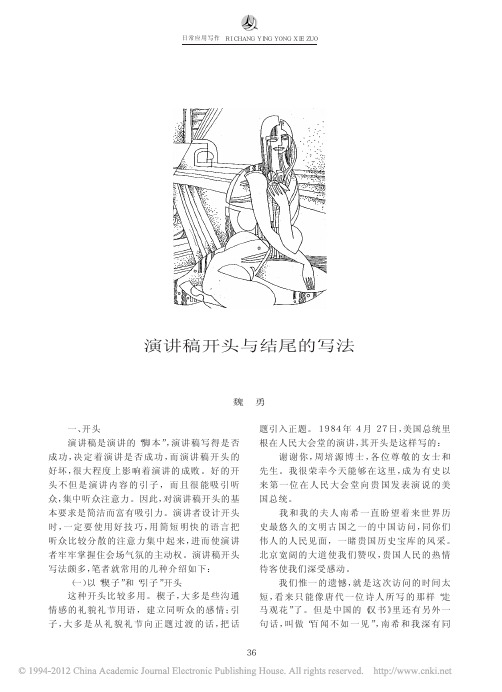
演讲稿开头与结尾的写法魏勇一、开头演讲稿是演讲的“脚本”,演讲稿写得是否成功,决定着演讲是否成功,而演讲稿开头的好坏,很大程度上影响着演讲的成败。
好的开头不但是演讲内容的引子,而且很能吸引听众,集中听众注意力。
因此,对演讲稿开头的基本要求是简洁而富有吸引力。
演讲者设计开头时,一定要使用好技巧,用简短明快的语言把听众比较分散的注意力集中起来,进而使演讲者牢牢掌握住会场气氛的主动权。
演讲稿开头写法颇多,笔者就常用的几种介绍如下:(一)以“楔子”和“引子”开头这种开头比较多用。
楔子,大多是些沟通情感的礼貌礼节用语,建立同听众的感情;引子,大多是从礼貌礼节向正题过渡的话,把话题引入正题。
1984年4月27日,美国总统里根在人民大会堂的演讲,其开头是这样写的:谢谢你,周培源博士,各位尊敬的女士和先生。
我很荣幸今天能够在这里,成为有史以来第一位在人民大会堂向贵国发表演说的美国总统。
我和我的夫人南希一直盼望着来世界历史最悠久的文明古国之一的中国访问,同你们伟人的人民见面,一睹贵国历史宝库的风采。
北京宽阔的大道使我们赞叹,贵国人民的热情待客使我们深受感动。
我们惟一的遗憾,就是这次访问的时间太短,看来只能像唐代一位诗人所写的那样“走马观花”了。
但是中国的《汉书》里还有另外一句话,叫做“百闻不如一见”,南希和我深有同感。
在里根的这次长篇演讲里,这段话是整个演讲的楔子。
既写了对演讲主持人及听众表示谢意的话,又写出了对东道主国表示赞叹,对东道主国的古老文化表示了解的言辞,这些都是沟通情感的礼貌礼节用语,正是这番话,融化了宾主本来陌生冰冷的气氛,架起了演讲者与听众之间情感的桥梁。
写完以上这番话后,演讲稿接着又写道:12年前,前总统尼克松来到北京,他走下空军一号专机同周恩来总理握手。
事后周恩来总理告诉他:“你那次握手是从世界上最浩瀚的大洋彼岸伸过来的手,是经过25年的完全隔绝之后伸过来的手。
”从那次握手开始,美国和中国都翻开了自己历史上新的一页,我认为现在历史又在召唤了。
小学生作文技巧-40种开头结尾的万能写法汇总
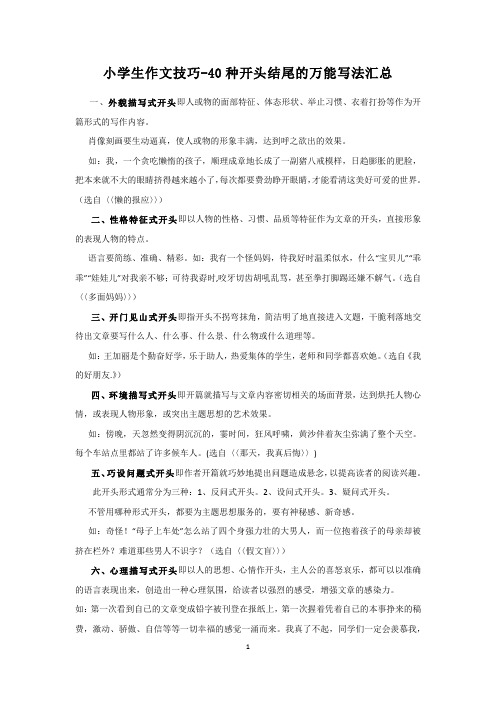
小学生作文技巧-40种开头结尾的万能写法汇总一、外貌描写式开头即人或物的面部特征、体态形状、举止习惯、衣着打扮等作为开篇形式的写作内容。
肖像刻画要生动逼真,使人或物的形象丰满,达到呼之欲出的效果。
如:我,一个贪吃懒惰的孩子,顺理成章地长成了一副猪八戒模样,日趋膨胀的肥脸,把本来就不大的眼睛挤得越来越小了,每次都要费劲睁开眼睛,才能看清这美好可爱的世界。
(选自〈〈懒的报应〉〉)二、性格特征式开头即以人物的性格、习惯、品质等特征作为文章的开头,直接形象的表现人物的特点。
语言要简练、准确、精彩。
如:我有一个怪妈妈,待我好时温柔似水,什么“宝贝儿”“乖乖”“娃娃儿”对我亲不够;可待我孬时,咬牙切齿胡吼乱骂,甚至拳打脚踢还嫌不解气。
(选自〈〈多面妈妈〉〉)三、开门见山式开头即指开头不拐弯抹角,简洁明了地直接进入文题,干脆利落地交待出文章要写什么人、什么事、什么景、什么物或什么道理等。
如:王加丽是个勤奋好学,乐于助人,热爱集体的学生,老师和同学都喜欢她。
(选自《我的好朋友.》)四、环境描写式开头即开篇就描写与文章内容密切相关的场面背景,达到烘托人物心情,或表现人物形象,或突出主题思想的艺术效果。
如:傍晚,天忽然变得阴沉沉的,霎时间,狂风呼啸,黄沙伴着灰尘弥满了整个天空。
每个车站点里都站了许多候车人。
(选自〈〈那天,我真后悔〉〉)五、巧设问题式开头即作者开篇就巧妙地提出问题造成悬念,以提高读者的阅读兴趣。
此开头形式通常分为三种:1、反问式开头。
2、设问式开头。
3、疑问式开头。
不管用哪种形式开头,都要为主题思想服务的,要有神秘感、新奇感。
如:奇怪!“母子上车处”怎么站了四个身强力壮的大男人,而一位抱着孩子的母亲却被挤在栏外?难道那些男人不识字?(选自〈〈假文盲〉〉)六、心理描写式开头即以人的思想、心情作开头,主人公的喜怒哀乐,都可以以准确的语言表现出来,创造出一种心理氛围,给读者以强烈的感受,增强文章的感染力。
作文开头和结尾的几种写法
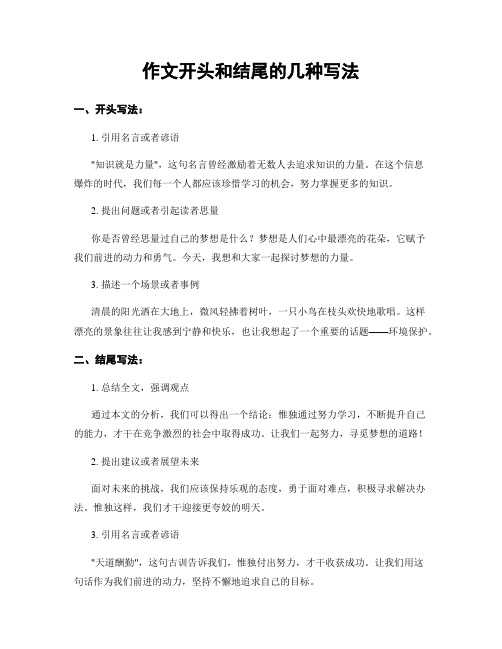
作文开头和结尾的几种写法
一、开头写法:
1. 引用名言或者谚语
"知识就是力量",这句名言曾经激励着无数人去追求知识的力量。
在这个信息
爆炸的时代,我们每一个人都应该珍惜学习的机会,努力掌握更多的知识。
2. 提出问题或者引起读者思量
你是否曾经思量过自己的梦想是什么?梦想是人们心中最漂亮的花朵,它赋予
我们前进的动力和勇气。
今天,我想和大家一起探讨梦想的力量。
3. 描述一个场景或者事例
清晨的阳光洒在大地上,微风轻拂着树叶,一只小鸟在枝头欢快地歌唱。
这样
漂亮的景象往往让我感到宁静和快乐,也让我想起了一个重要的话题——环境保护。
二、结尾写法:
1. 总结全文,强调观点
通过本文的分析,我们可以得出一个结论:惟独通过努力学习,不断提升自己
的能力,才干在竞争激烈的社会中取得成功。
让我们一起努力,寻觅梦想的道路!
2. 提出建议或者展望未来
面对未来的挑战,我们应该保持乐观的态度,勇于面对难点,积极寻求解决办法。
惟独这样,我们才干迎接更夸姣的明天。
3. 引用名言或者谚语
"天道酬勤",这句古训告诉我们,惟独付出努力,才干收获成功。
让我们用这
句话作为我们前进的动力,坚持不懈地追求自己的目标。
以上是几种常见的作文开头和结尾写法,希翼对您有所匡助。
无论是哪种写法,都要注意语言简炼、条理清晰,能够准确表达自己的观点和想法。
写作是一个不断积累和提高的过程,希翼您能够多加练习,不断提升自己的写作水平。
作文开头和结尾摘抄大全初三

作文开头和结尾摘抄大全初三一、悬念式开头与结尾开头:我就站在那儿,眼睛瞪得像铜铃,嘴巴张得能塞下一个鸡蛋。
那一幕,简直就像一道闪电击中了我,让我半天都回不过神来。
你们猜我看到了啥?是我那一向严肃得像块冰的班主任,居然在办公室里随着音乐扭动着身体,跳着一种滑稽的舞蹈。
这就像是平静的湖面突然投下一颗巨石,激起千层浪啊。
结尾:后来啊,班主任知道我看到了那一幕,脸涨得通红。
不过这件事就像一颗独特的星星,镶嵌在我初三的记忆天空里,每当我回想起来,还是觉得超级有趣。
这难道不就是生活给我们的惊喜吗?就像你以为盒子里是一块石头,打开却发现是一颗闪闪发光的钻石。
二、回忆式开头与结尾开头:“滴答,滴答……”雨滴敲打着窗户,我的思绪一下子被拉回到初三的那个操场。
那天的阳光特别好,同学们的笑声仿佛还在耳边回荡。
我、阿强和小美三个人在操场的角落里,分享着一块偷偷带来的小蛋糕。
那滋味,就像偷来的甜蜜,每一口都充满了冒险和欢乐的感觉。
结尾:如今,我们都在为中考努力,很少再有那样轻松惬意的时光。
可是那段回忆就像一坛老酒,越陈越香。
每当我在学习的重压下喘不过气时,就会想起那个操场角落的小蛋糕,那是我初三岁月里最美好的一抹甜。
这难道不是回忆的魅力吗?就像你在黑暗中握住了一束光。
三、引用式开头与结尾开头:“海内存知己,天涯若比邻。
”当我第一次读到这句诗的时候,就想起了初三的同桌。
他是一个特别温暖的人,就像冬日里的小火炉。
我们一起讨论难题,一起在课间打闹,那时候的友谊就像王勃诗里写的那样,即使距离遥远,也感觉心贴心。
结尾:初三的时光匆匆而过,我和同桌也即将面临分别。
但我知道,我们的友谊不会因为毕业而褪色。
就像那句诗说的,无论相隔多远,我们的心永远是近邻。
这友情不就像一首永恒的歌吗?在岁月的长河里永远悠扬地奏响。
四、环境描写式开头与结尾开头:清晨,雾像一层轻纱笼罩着校园。
那几棵老梧桐树在雾中若隐若现,像一个个神秘的巨人。
初三的校园在这样的清晨里,显得格外宁静,可我的心里却像揣了一只小兔子,因为今天就是模拟考的日子,这就像一场无声的战争即将打响。
专题02 开头结尾-高考语文议论文写作万能模板

万能模板之开头结尾
开头段:时代犹如一条未知的赛道,可能泥泞破败,也可能平坦通畅。作为
新时代新青年的我们,在xxxx (概括材料)的起点出发,面对(材料背景) ,以 (提出中心论点)的态度坦然前行,将一切际遇视为生命最好的安排,才能更好 地以个人渺小的微光,在时代中绽放出独特的光芒。
结尾段:东海扬尘,陵谷沧桑;数载寰宇,换了人间。新时代孕育 了我们,我们也有幸遇见了新时代。生逢其时的我们有应以(中心 论点)的萤烛末光增辉日月,化涓滴熵减汇入时代洪流,使国万里恒 昌。
万能模板之开头结尾
开头段:国内国外,猎猎红旗插遍的地方,只闻中华鹤鸣长歌于九皋。万里
的大地上, xxxx (概括材料),你我都秉承(提出中心论点)的信念,走在各自 腾飞的道路,为新时代贡献自己的力量,愿你我不忘初心,谱写新的篇章。
结尾段:一代人有一代人的长征,一代人有一代人的担当。丈夫志, 当景盛,耻疏闲。新时代中华民族的伟大复兴,面临前所未有的机遇, 也面临着诸多挑战,这更需要青年(中心论点) ,将个人与【理想 愿景】紧紧相连。
万能模板之开头结尾
开头段:雪满窗棂,我们看千山竞秀;月满西楼,我们看百舸争流; xxxx (概括材料),我们应(提出中心论点),能不负自己的炙热而蓬 勃的青春,用手中的笔,战胜黑暗的锤击。
结尾段:一滴水,不管多么晶莹剔透,太阳一晒就会瞬间消逝,然 而汇入大江大河,却能生机无限。一道微光,难以察觉,可是千万 道光聚在一起,足以驱走黑暗,所以吾辈青年都应坚定(中心论点), 同逐风波,才能破苍穹。
万能模板之开头结尾
开头段:若说生命是踽踽独行于暗夜,向着一场场未知摸索,那么(提出中心 论点)就是高擎的火把,给温热以暖身,赠光明以慰心。对于xxxx (概括材料), 我们要奏起(提出中心论点)的号角,在今日的上空响彻,为每一个赶路人注入 力量。
总结怎么写开头和结尾
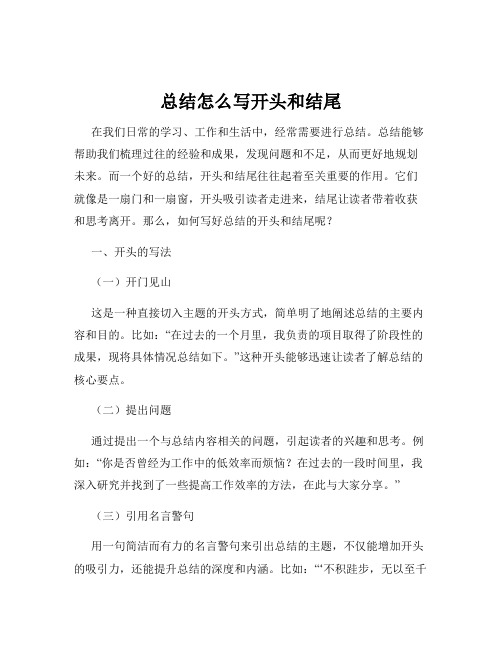
总结怎么写开头和结尾在我们日常的学习、工作和生活中,经常需要进行总结。
总结能够帮助我们梳理过往的经验和成果,发现问题和不足,从而更好地规划未来。
而一个好的总结,开头和结尾往往起着至关重要的作用。
它们就像是一扇门和一扇窗,开头吸引读者走进来,结尾让读者带着收获和思考离开。
那么,如何写好总结的开头和结尾呢?一、开头的写法(一)开门见山这是一种直接切入主题的开头方式,简单明了地阐述总结的主要内容和目的。
比如:“在过去的一个月里,我负责的项目取得了阶段性的成果,现将具体情况总结如下。
”这种开头能够迅速让读者了解总结的核心要点。
(二)提出问题通过提出一个与总结内容相关的问题,引起读者的兴趣和思考。
例如:“你是否曾经为工作中的低效率而烦恼?在过去的一段时间里,我深入研究并找到了一些提高工作效率的方法,在此与大家分享。
”(三)引用名言警句用一句简洁而有力的名言警句来引出总结的主题,不仅能增加开头的吸引力,还能提升总结的深度和内涵。
比如:“‘不积跬步,无以至千里;不积小流,无以成江海。
’在过去的一年中,我正是靠着点滴的积累,实现了个人的成长和进步。
”(四)描述背景介绍总结所涉及的背景情况,为后续的内容做好铺垫。
比如:“随着市场竞争的日益激烈,我们公司在产品研发和市场营销方面面临着诸多挑战。
在这样的背景下,我部门采取了一系列措施,并取得了一定的成效。
”(五)讲述故事以一个生动有趣的故事作为开头,能够迅速抓住读者的注意力,让他们更容易产生共鸣。
例如:“记得刚入职的时候,我对工作充满了迷茫和困惑。
但通过不断地学习和实践,我逐渐找到了方向。
下面是我这段时间的工作总结。
”二、结尾的写法(一)总结归纳对总结的主要内容进行概括和提炼,强调重点和关键成果。
比如:“综上所述,通过我们团队的共同努力,在项目推进、客户满意度提升等方面取得了显著的成绩,但在沟通协调方面还存在一些不足,需要在今后加以改进。
”(二)展望未来提出对未来的计划和目标,让读者看到积极的发展方向。
工作总结开头和结尾怎么写7篇

工作总结开头和结尾怎么写7篇第1篇示例:工作总结是对一段时间内工作的整体回顾和总结,能够帮助我们发现工作中存在的问题、总结经验、寻找改进的方法,是工作学习中不可或缺的一部分。
在进行工作总结时,开头和结尾是非常重要的部分,下面就让我们一起来看看关于工作总结开头和结尾的写作技巧。
一、工作总结的开头1. 开门见山工作总结的开头应该直截了当地表明总结的目的和主题,让读者在最开始就清晰地了解你要总结的工作内容。
可以简洁地阐述这段时间内的工作进展和成果,引起读者的兴趣和关注。
2. 点题引入在工作总结的开头可以通过引用一些启发性的语录、数据或案例,来引导读者对工作总结的内容产生兴趣,增加总结的吸引力和说服力。
3. 总结一段时间内的工作进展和成果开头部分可以简要概括这段时间内的工作重点、目标完成情况、遇到的问题和解决方案等内容,为后续具体的总结和分析做好铺垫。
1. 总结全文在工作总结的结尾要对全文进行简洁的概括和总结,再次强调本次总结的目的和主题,保证读者对你总结的工作内容有一个清晰而准确的认识。
2. 展望未来在工作总结的结尾可以展望未来,提出下一步的工作计划、发展方向或改进措施,为接下来的工作提供指导和参考。
3. 鼓励与感谢在工作总结的结尾可以适当表达对团队成员的鼓励和感谢,感谢大家在这段时间内的共同努力和奉献,激励团队继续努力,共同攀登新的高峰。
4. 诚挚致谢在工作总结的结尾可以以诚挚的语言表达对领导和同事的感谢和敬意,感谢他们在工作中给予的支持和帮助,让大家在共同的奋斗中更加团结和融洽。
工作总结的开头和结尾是整篇总结文中最为重要和关键的部分,要注意简练、明确、具体和感人,让读者在短时间内对你的工作总结有一个完整而清晰的认识,产生共鸣和共同进步的动力。
愿我们在接下来的工作中不断总结经验,不断提升自我,共同创造更加美好的明天!第2篇示例:工作总结是每个人工作后的必备步骤,通过总结工作内容和收获,可以让我们更好地反思自己的工作表现,发现不足之处,提高工作效率和质量。
遴选申论作文格式模板
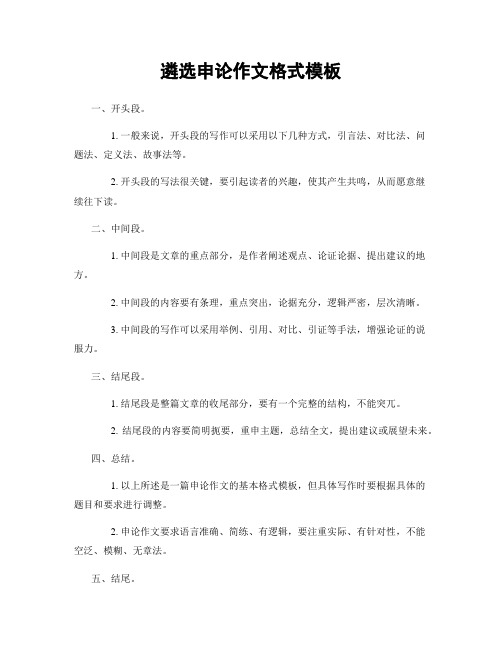
遴选申论作文格式模板
一、开头段。
1. 一般来说,开头段的写作可以采用以下几种方式,引言法、对比法、问
题法、定义法、故事法等。
2. 开头段的写法很关键,要引起读者的兴趣,使其产生共鸣,从而愿意继
续往下读。
二、中间段。
1. 中间段是文章的重点部分,是作者阐述观点、论证论据、提出建议的地方。
2. 中间段的内容要有条理,重点突出,论据充分,逻辑严密,层次清晰。
3. 中间段的写作可以采用举例、引用、对比、引证等手法,增强论证的说
服力。
三、结尾段。
1. 结尾段是整篇文章的收尾部分,要有一个完整的结构,不能突兀。
2. 结尾段的内容要简明扼要,重申主题,总结全文,提出建议或展望未来。
四、总结。
1. 以上所述是一篇申论作文的基本格式模板,但具体写作时要根据具体的
题目和要求进行调整。
2. 申论作文要求语言准确、简练、有逻辑,要注重实际、有针对性,不能
空泛、模糊、无章法。
五、结尾。
1. 希望以上内容对大家有所帮助,希望大家在申论作文的备考过程中能够认真对待,多加练习,相信一定会取得好成绩。
2. 最后,预祝大家申论考试顺利,早日实现自己的梦想!
以上就是一篇关于申论作文格式模板的文章,希望对大家有所帮助。
祝大家在备考申论作文的过程中取得好成绩!。
工作总结开头结尾的写法5篇

工作总结开头结尾的写法5篇篇1一、开头部分(约300字)本次工作的总结,首先需要概括性地描述整个工作的背景和目的,以及完成工作的总体情况。
具体来说,开头部分应包含以下几个要点:1. 引言:简要介绍本次工作的背景和目标,引出总结的主题。
2. 工作概述:概括描述工作的内容、范围及完成情况,为后续详细分析奠定基础。
3. 成果展示:简要阐述工作取得的成果和成效,突出工作的亮点。
具体写法示例:本次工作旨在达成XXX目标,经过全体成员的共同努力,任务得以圆满完成。
本次工作涉及XXX内容,覆盖了XXX领域,经过详细的规划和实施,各项工作得以有序推进。
通过本次工作,我们取得了显著的成果,实现了XXX目标,得到了领导和同事的认可。
二、主体部分(约400字)主体部分是工作总结的核心,需要对工作的具体过程、方法、成果及遇到的问题进行全面详细的阐述。
该部分应包含以下几个要点:1. 工作过程:详细描述工作的具体步骤和实施流程。
2. 工作方法:介绍工作中采用的方法和策略,突出创新点。
3. 成果分析:对取得的成果进行深入分析,提炼经验教训。
4. 问题与挑战:列举工作中遇到的问题和挑战,分析原因和解决方案。
具体写法示例:在工作过程中,我们按照预定的步骤和流程,有序推进各项工作。
采用了XXX方法,注重创新和实效。
通过努力,我们取得了显著的成果,如XXX。
然而,在工作中也遇到了一些问题与挑战,如XXX。
针对这些问题,我们深入分析了原因,并采取了相应的解决方案。
三、结尾部分(约300字)结尾部分是对整个工作总结的收束,应强调工作的收获、展望未来、提出改进建议以及对团队和个人的感谢。
具体要点如下:1. 收获体会:总结本次工作的收获和体会,提炼经验教训。
2. 展望未来:根据工作经验和教训,提出对未来工作的展望和建议。
3. 感谢致辞:对团队和个人的付出表示感谢,增强团队凝聚力。
具体写法示例:通过本次工作,我们深刻体会到了团队合作的重要性,收获了宝贵的经验教训。
精彩作文开头和结尾摘抄

精彩作文开头和结尾摘抄精彩作文开头和结尾摘抄在现实生活或工作学习中,大家都写过作文吧,作文一定要做到主题集中,围绕同一主题作深入阐述,切忌东拉西扯,主题涣散甚至无主题。
那么,怎么去写作文呢?下面是小编精心整理的精彩作文开头和结尾摘抄,欢迎阅读,希望大家能够喜欢。
精彩作文开头和结尾摘抄11、《爱》开头:透过历史的瞳孔,让尊严对你轻声低诉,诉说尘封的记忆里不朽的精神,诉说每一片感动,诉说每一价真情,诉说历史背后不泯的尊严。
结尾:站在历史中倾听尊严的低诉,终于明了:冽冽朔风中,不倒的是战士手中的旗;冰天雪地中,不冻结的是爱国的心;滚滚黑烟中,不变的是世界人民的和平的尊严!2、《我眼中的色彩》开头:天空是蓝色的,点缀着白云淡淡的闲散;大海也是蓝色的,激起浪花的浩瀚深邃。
心情也是有色彩的,火一般的愤怒,金光般的激情,半月似的忧郁……结尾:“最美不过夕阳红,温馨又从容。
”这是白发的爷爷奶奶眼中的色彩。
是的,不管追求哪一种快乐,最终都会成为夕阳的色彩,因为有过努力,有过奋斗,所以显得那么鲜艳,那么辉煌,那么光彩夺目。
3、《寻》开头:寻一抔泥土,上面印有你深深的足迹;寻一缕朝阳,照耀着你秀丽如画的容颜;寻一弯绿水,流淌着你生生不息的血液。
结尾:记忆中,我寻着你,千万次呼唤着你,芳香的泥土,温暖的阳光,清澈的溪流,茂盛的灌木林,古色古香的一排排小屋,还有你依旧不变的灿烂笑容……4、《一道风景线》开头:母亲下岗了。
结尾:人们常说,世上有一部书是永远写不完的,那就是母爱。
如果说,这世上还有一道最美丽的风景线,那,不是别的,那就是母爱这一道!5、《温暖的时刻》开头:温暖是初春的河上泛起的第一道涟漪;温暖是夜晚的庭院满溢的银色月光;温暖是傍晚天际擦过的飞鸿;温暖是令你怦然心动的一抹温存。
结尾:我几乎是躲在妈妈的怀里穿上了衣服,这时候我才感受到我和妈妈的心贴的是那么近。
我一手推着车,一手挽着妈妈的胳膊,一股暖流传递过来,暖暖地激荡在我的胸口。
作文写法格式模板

作文写法格式模板
作文是学生学习语文的重要组成部分,也是考试中的必考题目之一。
因此,掌
握作文写作的方法和格式是非常重要的。
下面我们就来学习一下作文的写作格式模板。
一、开头段。
开头段是整篇文章的引子,要简洁明了,引起读者的兴趣。
可以采用以下几种
方式开头:
1. 话题引入,引出文章的主题,让读者对文章的内容有所预期。
2. 引用名言,引用名言或者格言,增加文章的文采和深度。
3. 叙述事实,用一个真实的事例或者现象引出文章的主题,让读者对文章的内
容有所共鸣。
二、中间段。
中间段是文章的主体部分,要围绕文章的主题展开,论据充分,逻辑清晰。
可
以采用以下几种方式展开:
1. 分析问题,对文章的主题进行深入分析,从不同的角度进行论证,增加文章
的说服力。
2. 举例论证,用具体的事例或者现象来支撑文章的论点,增加文章的可信度。
3. 对比论证,对文章的主题进行对比分析,从而得出结论,增加文章的说服力。
三、结尾段。
结尾段是整篇文章的收尾,要简洁明了,给人以深刻印象。
可以采用以下几种
方式结尾:
1. 总结全文,对全文进行简明扼要的总结,强调文章的核心观点。
2. 提出建议,根据文章的主题,提出合理的建议或者展望,增加文章的深度和广度。
3. 引用名言,可以再次引用名言或者格言,增加文章的文采和深度。
以上就是作文的写作格式模板,希望同学们能够认真学习并灵活运用,写出优秀的作文。
精彩作文开头和结尾的方法技巧

精彩作文开头和结尾的方法技巧•相关推荐关于精彩作文开头和结尾的方法技巧作文讲究“凤头猪肚豹尾”,意思是说:好的作文开头要漂亮,内容要充实,结尾要有力量。
考场作文有时间限制,有字数要求,要想达到优秀作文的标准,就必须惜时、高效、力求语言生动、中心突出。
作为“风头”的开头,更是有着至关重要的作用。
以下是小编为大家整理的精彩作文开头和结尾的方法技巧,仅供参考,大家一起来看看吧。
一、概述法:从婴儿的“呱呱”坠地到哺育他长大成人,父母们花去了多少的心血和汗水,编织了多少个日日夜夜;从上小学到初中,乃至大学,又有多少老师为他呕心沥血,默默奉献着光和热,燃烧着自己,点亮着他人。
——《一颗感恩的“心”》开头概述一个人的成长花费了父母老师等多个人的心血,引出下文“感恩是发自内心的、需要满怀敬重的、有意义的”三个分论点,结尾再点“拥有一颗感恩的心给个人带来的影响。
”号召大家心存感恩。
是典型的并列式结构作文,思路清晰,中心突出,在考场作文中最常见。
二、假设式:也许,你只是理所当然地享受着父母的关爱,从而从无心注意他们两鬓上日益斑白的发丝;也许,你只是运用自己过人的智慧,将商场上的对手打得狼狈不堪,甚至倾家荡产。
而此时,你会说,“这是竞争”,而你可曾想,这会招来更多的“虎视眈眈”。
也许,你只是为了自己的一些蝇头小利,而欺诈行骗,到头来众叛亲离,而你却只管喜滋滋地沉醉于自己苦心得来的“战利品”上。
也许……也许,在自己心中的舞台上,你一直是一个独舞者。
——《心的舞台》本文为了表现“心有多大,舞台有多大”这一主题,开头运用了发散式思维,设想了生活中存在的几种现象,点其危害——“他将永远生活在‘自我’当中,直至孤独地死去。
”从反面切入正文,摆事实,讲道理,结尾点出中心。
这样贴合生活,使论述集中有力量。
三、特写式:好大的落地窗户!我看到阳光从窗口射进屋里,微微有些刺眼。
眯起眼睛,我看到了那熟悉的精灵在你额角闪烁光亮,在阳光下那般绚丽……——《劳动代表“我爱你”》本文记叙了小时候妈妈为我操劳,长大了我也学着为妈妈做力所能及的事情,全文紧紧围绕“劳动代表‘我爱你’”这一中心,开头即用特写镜头,写妈妈额头的汗水晶莹闪烁,从一个巧妙的角度切入了正文。
总结的开头,结尾,写法
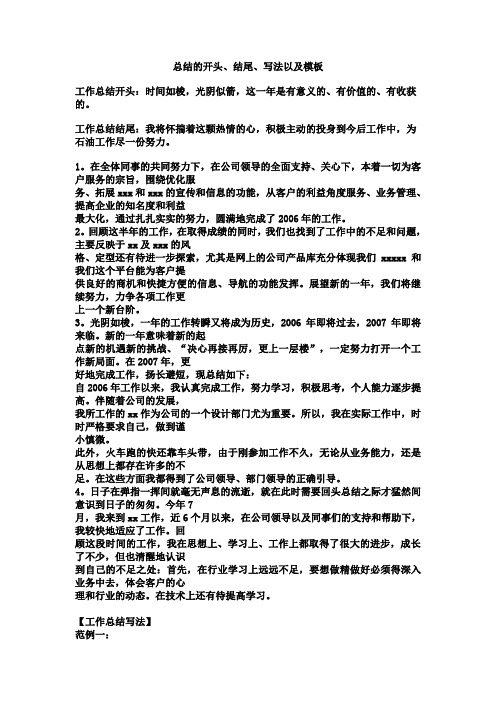
总结的开头、结尾、写法以及模板工作总结开头:时间如梭,光阴似箭,这一年是有意义的、有价值的、有收获的。
工作总结结尾:我将怀揣着这颗热情的心,积极主动的投身到今后工作中,为石油工作尽一份努力。
1。
在全体同事的共同努力下,在公司领导的全面支持、关心下,本着一切为客户服务的宗旨,围绕优化服务、拓展xxx和xxx的宣传和信息的功能,从客户的利益角度服务、业务管理、提高企业的知名度和利益最大化,通过扎扎实实的努力,圆满地完成了2006年的工作。
2。
回顾这半年的工作,在取得成绩的同时,我们也找到了工作中的不足和问题,主要反映于xx及xxx的风格、定型还有待进一步探索,尤其是网上的公司产品库充分体现我们xxxxx和我们这个平台能为客户提供良好的商机和快捷方便的信息、导航的功能发挥。
展望新的一年,我们将继续努力,力争各项工作更上一个新台阶。
3。
光阴如梭,一年的工作转瞬又将成为历史,2006年即将过去,2007年即将来临。
新的一年意味着新的起点新的机遇新的挑战、“决心再接再厉,更上一层楼”,一定努力打开一个工作新局面。
在2007年,更好地完成工作,扬长避短,现总结如下:自2006年工作以来,我认真完成工作,努力学习,积极思考,个人能力逐步提高。
伴随着公司的发展,我所工作的xx作为公司的一个设计部门尤为重要。
所以,我在实际工作中,时时严格要求自己,做到谨小慎微。
此外,火车跑的快还靠车头带,由于刚参加工作不久,无论从业务能力,还是从思想上都存在许多的不足。
在这些方面我都得到了公司领导、部门领导的正确引导。
4。
日子在弹指一挥间就毫无声息的流逝,就在此时需要回头总结之际才猛然间意识到日子的匆匆。
今年7月,我来到xx工作,近6个月以来,在公司领导以及同事们的支持和帮助下,我较快地适应了工作。
回顾这段时间的工作,我在思想上、学习上、工作上都取得了很大的进步,成长了不少,但也清醒地认识到自己的不足之处:首先,在行业学习上远远不足,要想做精做好必须得深入业务中去,体会客户的心理和行业的动态。
作文开头和结尾

开头和结尾开头“良好的开端是成功的一半”,一篇文章的开头是很重要的。
文章有了好的开头,不仅能带动全篇,使文章顺利展开,而且能抓住读者,引人入胜。
古人说的文章的“凤头、猪肚、豹尾”就含有这个意思。
这里,向大家介绍几种比较好掌握的记叙文的开头方法:一、开门见山法(1)交代事件基本要素的叙述法《挥手之间》的开头,交代了事件的时间、地点:“一九四五年八月二十八日清早,从青凉山望下去,见有不少人顺着山上大路朝东门外飞机场走去。
”《记一次乒乓球赛》的开头,交代了时间的人物、起因和时间。
(2)开门见山、揭示主题的点题法《背影》一文的开头写到:“我与父亲不相见已二年多了,我最不能忘记的是他的背影。
”《白杨礼赞》一文开头就说:“白杨树实在是不平凡的,我赞美白杨树。
”《美好生活的剪影》的开头使用的也是这种方法。
(3)把事情的开头作为文章开头的自然起笔法一篇题目是《记一堂生物课》的作文开头是这样的:“上课铃声响了,大家都走进了生物实验室。
”二、非开门见山法这里所说的“非开门见山法”,并非无“门”,而是使用写作技法(如议论、描写、抒情、引用等)、修辞方法(如设问、比喻等)或其它的方法(如设置悬念等)把“门”装饰的更美一些,使文章更添文采,进而更深刻、更生动地表现主题,更引人入胜。
如:(1)环境描写、渲染气氛的描写法《驿路梨花》的开头描写了自然环境:“山,好大的山啊!起伏的青色群山一座挨一座,延伸到远方,消失在迷茫的春色中。
”渲染了哀牢山中深远迷茫的气氛,对后文写边疆军民助人为乐的感人事迹起了衬托的作用。
例文《逝去的岁月》、《分房》开头使用的是这种方法。
(2)深化主题的议论抒情法课文《谁是最可爱的人》、例文《不寻常的考试》都是用了这种开头方法。
(3)名言、警句、诗歌的引用法《人民的勤务员》的开头:“人的生命是有限的,可是,为人民服务是无限的。
我要把有限的生命,投入到无限的为人民服务之中去。
”这是雷锋日记中一段著名的话,以这段话开头,对后文记述雷锋的事迹,无疑是起到了“文眼”的作用。
如何写好作文的开头与结尾

如何写好作文的开头与结尾如何写好作文的开头与结尾作文是学习语文时常见的任务之一,而写好作文是每个学生都希望达到的目标。
作文的开头和结尾是整篇文章的关键部分,能够为文章增加亮点和吸引力。
下面将介绍如何写好作文的开头与结尾,帮助大家提升作文写作的水平。
一、开头篇章开头是作文的门面,能让读者对文章产生兴趣并愿意继续阅读。
一个引人入胜的开头,能够赢得读者的关注,激发读者对作文主题的兴趣。
以下是几种常用的开头写法:1. 引用名言或故事:引用名人名言或动人故事,能够使作文瞬间跳出教科书的框框,激发读者思考的兴趣。
例如,写一篇关于友谊的作文,可以引用亚里士多德的名言:“友谊是一个心灵住所,在那里四季如春。
”引用名言能够为作文注入力量,让读者产生思考和共鸣。
2. 描述场景:通过描述一个引人入胜的场景,能够使作文的氛围更加丰富,并让读者沉浸其中。
例如,写一篇关于春天的作文,可以写一段如下的开头:“清晨,橙色的阳光洒在窗台上,微风轻抚着我的脸庞,仿佛春天悄悄来临。
”这样的描写能够让读者感受到春天的美好,从而对作文产生兴趣。
3. 提出问题:通过提出引人深思的问题,能够激发读者对作文主题的思考。
例如,写一篇关于环境保护的作文,可以在开头提出如下问题:“我们该如何保护我们的环境,让地球变得更美好?”这样的问句能够引起读者的思考和关注,激发他们对环境保护的意识。
4. 发表观点:直接表达自己的观点和见解,能够让读者对作文的主题有一个清晰的认识。
例如,写一篇关于诚实的作文,可以直接表达观点:“诚实是一种美德,它能让人们相互信任、共同进步。
”明确的观点能够给读者一个明确的导向,引导他们阅读和理解作文。
无论采用何种方式,一个好的开头应该有以下特点:引人入胜、生动有趣、有吸引力、鲜明突出。
二、结尾篇章结尾是作文的总结和收官之地,能够给读者留下深刻的印象。
一个好的结尾能够让读者对作文的主题有一个圆满的感觉,并产生共鸣和思考。
以下是几种常用的结尾写法:1. 总结全文:通过回顾全文,总结出文章的主要内容和观点。
- 1、下载文档前请自行甄别文档内容的完整性,平台不提供额外的编辑、内容补充、找答案等附加服务。
- 2、"仅部分预览"的文档,不可在线预览部分如存在完整性等问题,可反馈申请退款(可完整预览的文档不适用该条件!)。
- 3、如文档侵犯您的权益,请联系客服反馈,我们会尽快为您处理(人工客服工作时间:9:00-18:30)。
开头段的写作 • 一. 开头段的作用 表明文章的主题 提供题目的背景信息 引起读者的兴趣和好奇心 点明文章的重点, 目的和方向
• 二 开头段常见问题: • 1. 开头偏离主题—应尽快入题, 吸引读者 • 2. 逻辑混乱,篇幅过长—3-5句即可 • 3. 句子过于简单或语法错误多 文章开头往往给人重要的基本印象,不能过于简单, 全部使用一些基本的句型.文章开头要体现语法的 多样性,除了基本句型的使用外,可以适当使用六类 从句,非谓语动词,倒装句, 强调句.但很多学生在使 用复句的过程中会出现句子成分不完整, 句式杂糅 等语法错误.
四 常见结尾段的写作方法
• 1. 总结归纳 • 文章最后用几句话概括全文内容,并进一步肯定文 章的中心思想.这种收尾方式也非常有力度., 他能 让读者对 短文主题有更完整而清晰的理解. • 用总结归纳来结尾,一般都有一些特定的词组来引 出结论: • In general / on the whole/all in all/ in brief/ in summary/ in conclusion/ in short/ in a word/ to sum up/ to conclude/ to summarize/ generally • 或者是一些常用的总结句, 如:
3 主题句法(开门见山法)
• 文章一开始便以主题句点明全文主题,然后围绕主题内容 进行发展.For example: • Now people become increasingly aware of the importance of acquiring a mastery of a foreign language. To them, the knowledge of a foreign language often means a good opportunity for one‟s career, even a passport to a prosperous future. Many of them equate success in life with the ability of speaking a foreign language. • 注: 主题句法是最常见的开头方式, 开门见山提出主题后, 经常可以简单举例, 说明原因,列举不同观点或阐释作者观 点.这些方法可以选其一或二用于段首主题句后,但要注意: • 并不能过多地阐释,一定要简洁清楚. • 最好避免和下文扩展段重复,如扩展段要写原因,那么在开 头可举例说明该现象的表现.
5. 给出背景(故事法)
• 描述具体事件的时间,地点和发生背景., 然 后引出主题。
6. 概括法
• 提出一个与题目相关的引人注目的事实以 引起读者的好奇心和阅读兴趣, 然后引出 主题。 如 Reduce Waste on Campus的开 头就使用了这种方法: 一开始指出校园内 浪费现象到处可见的现状, 接着是具体的 事实, 最后点出主题说明这一现象受到了 大家的普遍关注。
常用总结句型
• 1. Judging from all evidence offered , we may reasonably come to /draw the conclusion that… • 2. From the above comparison and contrast, anyone can safely conclude that… • 3. From what has been discussed above, we may safely arrive at the conclusion that… • 4. Taking into consideration/account all these factors, we may reasonably come to the moral that… • For the reasons presented above , I strongly commit to (完全接受)the notion that …
4. 提问开头
• 提出有争议或探讨性的具体问题,然后加以简要 回答或展开引导性简短讨论. For example: • What do you want from your work: Money? Promotion? Interesting challenges? Continual learning? Work-based friendships? The opportunity to develop your own idea and potentials? Though we are all individuals and so our answers will differ, all agree that work provides more than material things.
直接引语
• 1. A proverb says, “ Honesty is the best policy.” • 2. One of the greatest early writes said “…” • 3. “…”. That is how sb. comment (criticize/praise). • 4. “…” How often we hear such words.
• 7. As far as I am concerned, I am in favor of the opinion that… • 8. For my part, I completely agree with the former/ latter. • 9. To be frank/ To tell the truth, I should second the former/latter attitude/ position in preference to the latter/ former. • 10. For the reasons given above, I feel that…
• 二 结尾段的内容: 对中心思想的总结。 对主题的解释。 结束句(最后的评论)。
• 三 结尾段应注意的问题 • 1. 不可偏离主题, 突然毛出不相关的新话题 或提出与主题句 相互矛盾的观点. • 2. 不可过于冗长,结尾应简洁鲜明,以提议结 尾的时候不用过于展开. • 3. 不可过于依赖模板来结尾,要灵活使用结 尾句型,避免陈词滥调牵强附会地收尾. • 4.不要过于武断,绝对化地提出总结,应该留 有余地,保持一定的客观性.
间接引语
• It goes without saying that… • As everyone knows… • No one can deny that …
2. 数据开头
• 引用一些具体数据,然后作出概括性分析, 指明问题 的症结所在,这样的开头方法更有说服力. • 开头时为了表明某一现象普遍存在,我们可以列出 有利数据,有的是有明显来源的,有的可能来源比较 模糊,或直接为作者所杜撰,不管 是哪种情况, 都要 注意数据要能支持观点,又要有一定的合理性. 在引 用数据时, 我们一般可以套用句型: • According to a recent survey, … • Recent statistics show that …
8. 综合法
• 具体写作时不只使用一种开头法, 有时可 以综合上述两种甚至两种以上的方法。
结尾段
• 一 结尾段的作用 结尾部分是想读者留下深刻印象的最后展 示机会,应该简要但有效地突出强调文章 的中心思想,或说明中心思想的重要性, 或回答文章前一部分提出的问题。总之, 结尾段是文章的总结和思想的最后升华, 它应起到再次肯定和强调主题的作用。 结 尾段应短小有力,言简意赅,却又意味深 长。
• For another example: • On Students‟ Selecting Lectures 的开头段: • Recently, quite a few universities have allowed their students to choose their own teachers for certain courses. Then how to choose the teacher? What are the effects? These questions have aroused a wide concern on campus.
四 开头段的表达方式
• 1. 引语开头(quotation) • 使用相关的名人名言,或人们常用的谚语,习语 , 以 确定文章的写作范围和方向. 如果能用好一些英语 谚语,那时非常出彩的. • 注: 引语一般可分为直接引语和间接引语,对于那 些自己非常熟悉的并且已经记住的名言可以采用 直接引语形式,而不是很确定的名言或作者根据理 解记忆改编的名言可以用间接引语形式.这两种引 语方式都可套用一些固定的句型, 如:
二 作者观点
• 各方观点分析过后,提出作者的观点,是作者经过分析而升华 出来的更完整的主题. • 经典句型有: • 1. If it is up to me to make a choice between A and B, I would rather choose over… • 2. If I were forced to agree with one of the two , my choice would be… • 3. All these opinions make sense, and consequently it is hard to choose the best of them. In my opinion, such matters must be left to individual‟s conscience. • 4. Personally, I side with the former/ latter opinion. • 5 I am of the opinion that priority should be given to … • 6. Personally, I stand on the side of …
